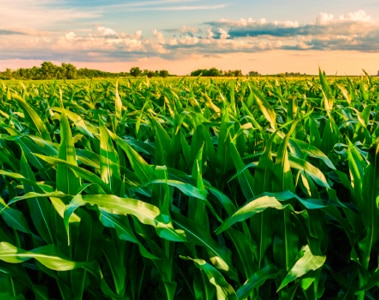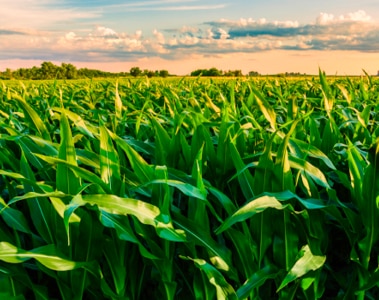
Mycotoxins: The Invisible Profit Killer, Part 1
Part 1 - Will 2022 harvest bring mycotoxin challenges?
Mycotoxins are persistent and stable compounds, so once they’re produced, they generally remain in feeds through the time of feeding. Prevention of contamination is the goal, but many factors influence the occurrence of molds and production of mycotoxins, including factors that are beyond our control like weather conditions, making total prevention difficult. An added challenge is that mycotoxins can be produced at any time starting with the crop in the field prior to harvest up until the animal consumes the feed. Therefore, it’s nearly impossible to eliminate the risk of mycotoxins despite our best efforts. Since 2022 harvest is underway, this article is going to focus on testing and mitigation options rather than prevention since many preventive measures hinge on decisions and management practices implemented around the time of planting. We will re-visit prevention methods in another article this winter in preparation for 2023 planting. So, how do we know if mycotoxins are present and what can we do if they are? The first step in addressing mycotoxin contamination is understanding what type(s) and level(s) of mycotoxins are present.
How can you tell if mycotoxins are present in your feed? Special analysis is needed to determine the presence of mycotoxins because they are tasteless, odorless, and invisible. Although visible mold growth indicates there is potential for mycotoxins, it does not guarantee the presence of contamination because many types of molds can infect feeds, but relatively few produce mycotoxins. And just because you don’t see mold growth doesn’t mean the feed is free of mycotoxins. Visual inspection may overlook mold growth which is not exposed or capable of being seen with the naked eye. Additionally, mycotoxins are stable and more resilient than the molds that produce them, so it’s possible for the mold to die off, but the mycotoxins will remain – this is especially true with fungal disease that occurs in the field prior to harvest. Those molds don’t tend to survive proper storage conditions, so the absence of molds doesn’t guarantee a lack of mycotoxins.
Sampling and detection of mycotoxins can be challenging since mycotoxins are not evenly distributed in feeds and they occur at low concentrations (parts per million (ppm) and parts per billion (ppb)). Therefore, collection of a representative sample is essential to obtain reliable results. If you have questions about how to collect samples, contact your dsm-firmenich representative learn more about sampling best practices.
When it comes to the actual analysis, various testing methods are available to screen feed for mycotoxins. Different methods differ in their ease of use, speed, cost, suitability for different types of feeds (raw commodities vs. complex ingredients like corn silage or complete feeds) as well as which mycotoxins can be screened for. Lateral flow devices (LFD) and enzyme-linked immunosorbent assays (ELISA) enable rapid identification at a relatively low cost but have limitations as to what mycotoxins can be screened, potential for cross-reactivity, and are only suitable for use on raw ingredients. Liquid chromatography coupled to tandem mass spectrometry (LC-MS/MS), is suitable for screening complex feedstuffs and is highly sensitive but comes at a much higher cost and requires a longer turnaround time as samples need to be submitted to a reference lab. Advanced techniques enable screening for a wide range of mycotoxins and allow for testing of complex matrices which is important especially for ruminant feeds including forages as well as total mixed rations (TMR).
Analytical techniques continue to improve with enhanced sensitivity and specificity, leading to greater reliability and better accuracy. Although challenges exist when testing feeds for mycotoxins, analytical results can provide useful information to producers to help guide mitigation strategies and other management decisions whether testing is done for surveillance purposes or when troubleshooting clinical concerns on-farm.
Various physical, chemical, and biological mitigation methods have been investigated, but their success is variable and dependent on the method used and the mycotoxin(s) being addressed. Although chemical treatments have been described, these can result in residues, may reduce palatability and nutritive value of feeds, and have variable efficacies. Therefore, physical and biological methods are focused on here.
Physical mitigation approaches. Reducing animal exposure to mycotoxins is key to limit negative consequences, but complete substitution is not always possible when feeding livestock due to limitations in various factors such as feed inventories and cost required to purchase alternative feeds. Some physical methods of decontamination include sorting, washing, dehulling and thermal treatment, but their efficacies vary. It is best to discard spoiled feeds which have visible mold growth. When suitable, combining feed ingredients may dilute the final mycotoxin contamination levels in the diet. Substituting feeds through diet reformulation can also be considered. However, mixing feeds or swapping ingredients may inadvertently increase contamination levels; caution is warranted when the mycotoxin contamination status of feed ingredients is unknown. In some cases, the practice of dilution is not permitted.
Biological or in-feed mitigation options. The FDA does not currently permit feed additive claims related to mycotoxin control. In the EU, products can be registered under the category “substances for the reduction of contamination of feed by mycotoxins” after completing a stringent evaluation process to prove safety and efficacy of the product to address the mycotoxin in question.
There are commercial products available on the market including inorganic clay minerals (e.g., bentonite, hydrated calcium sodium aluminosilicates, zeolite, etc.) and organic products (e.g., yeast, yeast cell wall, algae) which are reported to bind (adsorb) some mycotoxins. The physical structure and chemical properties of the mycotoxin as well as the binder material itself as well as the pH of the gastrointestinal tract determine how well binders perform. Additionally, binder products vary tremendously in their composition, leading to variability in their effectiveness. Much research into feeding non-nutritive adsorbent materials to livestock has been done. Aflatoxins and some ergot alkaloids are reportedly controlled well by binders while other mycotoxins, such as fumonisins, zearalenone, and trichothecenes are not as readily bound. Other potential detoxification approaches have been described for toxins which are not easily controlled via binding.
Fumonisin esterase or FUMzyme® is the first and only FDA-approved enzyme for the degradation of fumonisins in swine and poultry feed. This innovative enzyme technology detoxifies fumonisins by converting the parent mycotoxin into non-toxic metabolites and has been available in the EU since 2014. Fumonisin esterase will soon be available in the US as part of the products Biofix® Plus with FUMzyme® and Biofix® Select with FUMzyme®. If you would like to learn more about these new products, contact your dsm-firmenich representative for additional information.
Additionally, several plant and algae extracts have been reported to enhance natural protective mechanisms in animals by augmenting gut integrity, supporting immune function, and promoting liver health. Combination products which offer multiple modes of action including binding capacity, degradation activity, and supply protective plant and algal extracts can provide broad-spectrum coverage in challenging situations.
Application of best management practices from planting through the time of feeding cannot guarantee total prevention of mycotoxin contamination as many factors influence mold growth and mycotoxin formation, including weather conditions which are beyond our control. Currently, screening feed is the most effective way to identify the presence of contamination and gauge potential mycotoxin exposure in livestock. If mycotoxins are detected, analytical results can be paired with assessment of clinical signs on-farm to guide management decisions. Development of a mitigation strategy is warranted in order to reduce animal exposure. A variety of mitigation options exist such as discarding contaminated feed, dilution of contamination ingredients, reformulation of the diet, or consideration for the use of another method of decontamination or detoxification. It is recommended that livestock producers consult their nutritionist and veterinarian to develop a comprehensive mycotoxin mitigation strategy.
17 October 2022
Not all products are available in all markets nor associated claims allowed in all regions (including but not limited to USA and Canada).

Part 1 - Will 2022 harvest bring mycotoxin challenges?

Part 2 – Harvest Insights for your Operation
We detected that you are visitng this page from United States. Therefore we are redirecting you to the localized version.